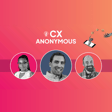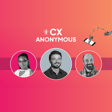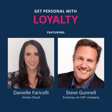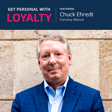Become a Creator today!Start creating today - Share your story with the world!
Start for free
00:00:00
00:00:01

The Stakeholder Game: Six Blind Men, the Elephant and the Pain Chain
The Loyalty Lounge Powered by Annex Cloud Presents CX Anonymous: The Stakeholder Game: Six Blind Men, the Elephant and the Pain Chain. Clarity around the problem to be solved can lead to a poorly built final product that may meet the individual needs of stakeholders but is not functional as a whole. Mark Michelson discusses uncovering the elephant from all angles and understanding the leg pain is connected to the arm pain of the pain chain.
Transcript
Introduction to Stakeholder Management Series
00:00:05
Speaker
Welcome to CX Anonymous. This series, the stakeholder game, is going to talk about that internal and external stakeholder management that we all have to take part in to get those initiatives out the door. I'm Amber Collins, Product Marketing Manager here with Scott Sherson, Product Solution Engineer, and a host of guests, including our guest today, Mark, to discuss the pitfalls, opportunities, and the joys of the stakeholder game. So let's play.
Complexities of Large Project Management
00:00:37
Speaker
So I think we all know that managing the upstream downstream of a large project such as developing a loyalty program can be a pain in the, you know what, depending on your role in this process, you're going to deal with different risks, goals, timelines, and stakeholders. So let's talk about it. Let's talk about what we call the pain chain and why it exists and how to get started eliminating those obstacles to success. And for context, none of us are sales.
00:01:07
Speaker
I spend my time trying to understand and communicate the solution to your problems and Scott spends his time implementing those innovative solutions.
Understanding the 'Pain Chain'
00:01:17
Speaker
So you may or may not be familiar with the pain chain. So this is my quick synopsis and understanding. If you think about the song, everybody hurts by REM or REM depending on your perception.
00:01:31
Speaker
If your department has pain somewhere, chances are, highly chances are, somebody else somewhere else does too. So imagine we're all connected on a line and someone downstream starts to have a problem. Eventually, that problem will become the upstream's problem. And since the upstream is the input to the downstream's output, suddenly everybody has a problem.
00:01:55
Speaker
And it can result in one thing, but each person is going to have a different contribution to that problem and has a different result that they need to solve when they experience that problem. So it's easy to think, oh, if marketing would just collect better data or sales would just forecast better and point to a weak link. But the truth is the entire chain is the problem. And sometimes solving one link creates new chains or breaks it all together.
00:02:25
Speaker
So again, I feel like most of us probably has some understanding of this and may not have communicated it as the pain chain. But all too often, us as vendors discover that our prospects are operating in a vacuum. They're unaware of the links in their chain. And so ultimately, we want your projects to succeed. We want your stakeholders to be happy, and we want our software to change the way you do business. So Scott, how would you describe the pain chain? Sure. To me, the pain chain
00:02:55
Speaker
comes down to a business is a collection of humans, just people with their own agendas and their own set of goals and experiences. So each person within an organization, they're coming at the problem with a different set of eyes, with a different set of needs and a different set of KPIs. What is motivating them to succeed in their business, whether that is
00:03:20
Speaker
I just need to make sure that I keep the lights on. I need to grow revenue. I need to grow my department. Everybody's coming at every project from a different perspective. The pain chain seeks to understand that concept, that everyone is different. It has their own agenda and their own way of approaching the project and understanding each of those individuals along the chain because they are all interconnected at their customer site.
00:03:50
Speaker
Ultimately, they are collaborating together just as we are collaborating together at our company. They work together for a common goal, but they've all got different motivations. Understanding each of those motivations allows you to say, I'm not just addressing the company need or a singular need within an RFP, but I'm helping you and I'm helping you and I'm helping you and I'm helping you. Everybody gets help and everybody gets a little love at the end of the day.
00:04:19
Speaker
So to me, that's really the pain chain, is understanding those wants, needs, desires, drives of each individual person, and then speaking to them like humans, people by from people. So let's treat them like that.
00:04:33
Speaker
Absolutely, I love that perspective.
Perspective Through the Story of Six Blind Men and an Elephant
00:04:35
Speaker
And so we have a guest today, Mark Mickelson. He's the founder of the CX Forum and a good friend of mine. So Mark, when we met up last month, you talked to me about a story, this is why I met in the elephant. And so I would love for you to recall that story and help us put it in the context of executing customer experience and the stakeholder game. Sure, yeah.
00:05:02
Speaker
The idea that people don't really know what the bigger vision is, a lot of times they're blinded by their own silo. And this is the story of the elephant first. Let me share what that is. So it's not my story. It's something that I've learned a long time ago. It's from a poem that's actually based on an old Hindi story. But essentially, there's six blind men who wander around India or somewhere.
00:05:30
Speaker
And they come across an elephant, right? And this elephant, they've never seen it. Well, they've never seen much because they're blind, but they don't know what this elephant is. And so they all decide to sort of feel what it is. And each blind man feels a different part of the elephant's body. But only one part can each one of them feel like, say, the side of a tusk or a tail or the ear, you know. So each one of them thinks that they're looking at different things. They say, oh, it's a tree. It's a wall. It's a snake. It's a rope.
00:05:58
Speaker
It's all these things because they're limited by their vision. Not only their vision, but their only thing that you have to go by is touch and talking to each other. It's almost like they get in arguments, because it's like, no, it's not, it's this. And they're saying, no, it's not, it's that. But they never get the whole animal in their vision. And I think, to me, when we were talking earlier, a goal of mine, particularly when it comes to something like the pain chain, I'd even call it the playing game, if you will,
00:06:28
Speaker
I would say that they're running through a lot of issues because there's a lot of different visions of what needs to happen. And it may have to do with origin, right? What's your origin when you come to the job? As someone who hires a lot of people and have done so through years, I would be in a position where I'd say, okay, look, I need someone that's really good at accounting to do my accounting work or, you know, bookkeeping versus, say, you know, CFO work, right? Or I need someone that's really good with people.
00:06:57
Speaker
HR kind of person or sales, or I need someone that's really good with technical. Each of those are different personality types and they come from different origins. Those origins, I think, in a way, color our world as we go forward. For instance, if you come from contact center, the whole world, the solution around customer experience lives in the contact center versus product designer,
00:07:27
Speaker
where they're saying, ah, everything's about the design of the product. It's Genesis is with that product and how it grows. And I really think when it comes down to how do you get those folks in on the same page, the elephant is a good analogy there because if they could see the whole elephant and understand why and where it's going,
Influence of Personal Origins on Project Approaches
00:07:53
Speaker
right? The owner or the person who creates the original vision
00:07:57
Speaker
really has to be clear in saying this is the picture. And then you got a Tom Sawyer, everyone into helping you get there. If you know what I mean. Yeah, I mean, catch more flies with honey than vinegar.
00:08:12
Speaker
But sometimes you can't even, you may think that you're coming to the table with some honey and it's not really honey for them. And so I love that you said, where are people's origins and trying to understand sort of what is their vision of success for them? What problem do they have to solve that is within this larger problem, right? What function does the tail do on the elephant and how does it fit for the function of the elephant? And I think that that really comes from
00:08:37
Speaker
building those relationships, building those cross-functional relationships, understanding how people are measured, what their success is, and pulling that into that bigger picture. Like you said, getting on the same page and the owner, you know, sometimes the owner is not necessarily that project manager and they've got this focus on what their money is, what their success is. And so how can a great kickoff, even if you're the owner and you're not necessarily the best at communicating that mission, how can a great kickoff help people see the whole outfit?
00:09:08
Speaker
That's a great question. Scott, have you got an idea on that or should I jump in? Well, I think it, first of all, the answer is easy, but the execution is difficult, right? Get to know each person along the chain and what their individual motivators are. It's easy in concept. I'm going to have a meeting with them or I'm going to have a meeting with Mark. I'm going to have a meeting with Mark. I'm going to do each of these meetings. I'm going to get to know you. In practice, it sounds easy, right? Like, yeah, let's just have a chat. But an execution is pretty difficult because either there's
00:09:38
Speaker
very strict procurement process in there and people's times are limited. Also, as we just discussed, everybody's different and their ability to dedicate themselves to a given project, loyalty or otherwise, is really valuable to them. Like my time is limited and valuable. So they can't have these get to know you meetings with every potential third party or external group that wants to get involved with them.
00:10:07
Speaker
The other side of that coin too is, has your own team had that alignment? Oftentimes people get thrown onto the field to play football or something and they've never played before. And it's very obvious that they don't know what each other's motivations and capabilities are. So before that kickoff even happens, has that team had that alignment? Have they discussed that
00:10:32
Speaker
we are about to approach this thing. Everybody give me your perspective of what you see, and then we'll try to piece together what this elephant looks like from that. Or are they just motivated by, I need to get this one touch and describe this entire elephant, and I'm right because this is what I perceive. So I think that there's that perspective just before we even get to the kickoff. Mark, I don't know, are you? Yeah, you know, it's interesting because I guess,
00:10:59
Speaker
We're really talking about two different stakeholder groups, okay? And when you have any type of organization, let's say it's a client organization, right? The size, the scale, how long they've been around, what kind of systems they have in place, the maturity level, all that plays into it, right? When you're doing on the supplier side, your team really has to match up to the other one like tugs in a wheel, right?
00:11:26
Speaker
It's kind of rare that someone from down here is going to jump up to the C-suite and say, hey, I'm so-and-so from tech support. Maybe you understand what your vision is. It's kind of hard to do that. You have to have someone that's guiding that process along. Usually, whoever that is has a relationship already with that client of some type. Now, if you've got that relationship and you open the door,
00:11:54
Speaker
Then, you know, well, frankly, one of my things I have to do for my day job, if you will, is sit around and have these conversations and get to know everyone. So typical, I would get paid to sit around and do an hour-long interview with, say, 30-something stakeholders, right, so 30 hours there, and then conduct a survey to quantify it. So where I'm going with this is the difference between qualitative and quantitative.
00:12:23
Speaker
The qualitative is getting to know you, but also what are your pain points? What's your big hurdles? What are you dealing with? What's your origin? What are your KPIs? How are you measured? When you have measures of success out there for people and that's all they see, especially if their income is tied to that or some sort of incentive, they're going to push that no matter what. They're going to push their agenda so they get their carrot. We were talking about honey. They're going to push that agenda.
00:12:53
Speaker
may or may not be in the best interest of the group because the KPI was set up almost like out of the box. Oh, we need to have an NPS score. Why? What are you going to do with it? It's the information around the score that matters. Why did you give it that score? Who are you? What's your pain point? What are you dealing with? Those are human questions. And that's what I'll spend the first part of every project doing.
00:13:21
Speaker
It's all transcribed and all. It's very formal, right? But I think it can be done on an informal basis too. You know, it's nothing like meeting in person, especially these days, right? Go out for a beer, a cup of coffee, or whatever. Just, you know, have a focused chat, you know? You know what you're looking for, but the basic questions are not hard. It's just remember to try to uncover what's your origin? What are your pain points? How do you know you're doing good? You know, what would you like to get out of this deal?
00:13:50
Speaker
You know, why are you, why are you doing this? There's also that old adage, what gets measured is what matters. Well, yeah, what gets done. I mean, we did, we did, speaking of the anonymous thing, I did mystery shopping and large scale mystery shop for years. And, um, you know, that, that phrase, uh, was, uh, uh, I forgot Tom Peters came up with what gets measured gets done. Okay.
00:14:15
Speaker
And so that's true. You have to have some sort of measuring stick for management, right? At least to know people are getting the basics done. But does it really move the ball? Yes and no. It helps if everyone understands, I'm getting measured on this because this is where we want to go, right? And it's almost like the life of a consultant. If you go in and you sell process, right? Are you talking process? Processes, you know,
00:14:43
Speaker
how I'm going to about do something, whatever it is. I'm going to feel this tail. I'm going to feel this tusk. I'm going to knock on the tusk and decide it's hard. Those are process things. But the ultimate thing clients really want to know is how do I go from here to here? I want to know what's that magic formula where I go from maybe 1.2x to 10x, 10 times.
00:15:11
Speaker
And that kind of leap doesn't come across very often. And I've noticed recently, like with AI, right? It's going to be taking a lot of people's harder tasks of being able to speak and write properly and say, okay, start on top of that. Let's start on top of all this stuff we know already. And sometimes that's okay. That's process stuff. That's stuff that's already out there.
00:15:41
Speaker
that you should know the rules of the game when you're going to play football, right? AI can solve that for you real quick, but the creativity to move beyond that context is really where we make a difference, you know, as humans. And sometimes we as consultants need to help the customer to realize that, because again, with that measure gets done mentality, a lot of, you know, the customers that we talk with and, you know, perspectives that we talk with,
00:16:10
Speaker
They are saying, I need to move this needle by this much, or I need to make this change for this reason. And helping them understand that this is how we're going to transition, and this is how we're going to help you. But here's how I'm going to help all of these other groups. Here's how I'm going to help all of these other people. And not only am I solving your problem, solving these other problems, it helps you be a better steward of goodwill.
00:16:40
Speaker
cooperation within that organization. It's not just, we're going to solve this problem. Here's a toothpick, get the lettuce out of your teeth. Like it's one and done, right? It's got to be a more... Exactly. What ultimately is that toothpick doing? Like you're going to be on camera, we're going to take a picture of you. Like there's a bigger picture here rather than toothpick and lettuce. Like helping our prospectus realize that is a big, is it important to us as
00:17:09
Speaker
the ability to solve the immediate problem, right? Yes, what is it going to do? How is it going to make your life easier? How is this going to help you relate to the rest of your department and your stakeholders? How is this going to help you communicate that whole elephant out and put it in the herd of the rest of the elephants that the organization has so that you all move together in towards whatever that destination is? I think a lot of times also
00:17:39
Speaker
people are still focused on their elephant that until there is this pain chain of this problem of you're experiencing this in marketing, is it possible that this is also an experience that's happening in sales? And they look up from their elephant and say, oh my gosh, they've got an
Why Understand Stakeholders Before Project Kickoffs?
00:17:53
Speaker
elephant over there too.
00:17:54
Speaker
And I never thought about that. And so how do our elephants play nicely together? And how do I prioritize where this elephant wants to go with where my elephant wants to go? And then, of course, you start to get beyond the departmental into those organizational herds. And how are we going to get everybody in that same direction while still understanding that they're individual elephants? And so I want to talk a little bit about
00:18:21
Speaker
We've uncovered that other people have problems. We've uncovered that other people have other measurements.
00:18:28
Speaker
It seems like with this discussion of the pre-kickoff that you should probably be exercising this muscle of starting to understand your stakeholders before you need your stakeholders to help you put a project and initiative together and get out the door. And so, due to Scott's point of it, the answer is easy. The execution is difficult. Starting to exercise that muscle before you go to that kickoff, it's that pre-kickoff. Say you've had that kickoff,
00:18:54
Speaker
Say we've managed to have a clear vision. Say we have discovered the whole elephant. Scott, you briefly touched on post-kickoff. How do we continue to keep everybody in that alignment, making sure that it is a priority for them? Because things start off with so much energy, and then they can quickly say, I've got other priorities over here, and so this one has fallen down the totem pole. How do we keep the momentum when managing stakeholders?
Post-Kickoff Stakeholder Engagement Strategies
00:19:20
Speaker
How do we keep their priorities and how do we
00:19:23
Speaker
show enough milestones to keep that momentum. You brought up a lot of issues there. I love this. In the world of research, it really starts off with, what are we trying to achieve? What are the objectives? It's really like know yourself. You have to know yourself first, know your team. What are we trying to achieve? It's usually an ad hoc situation. Once you know it, you don't need to go back and relearn it, you just got to pay attention.
00:19:53
Speaker
So if you say, how am I going to get there and how do I affect change? I can tell you some things we've done to affect change and keep people's eye on the ball. Okay. One of them is the phrase, you want fries with that. With McDonald's, they knew they could increase sales. If they just got every sales, every order taker to say, would you like fries with that? Would you like something to drink with that? And so each.
00:20:22
Speaker
period of time, it was like almost a year that we'd spend mystery shopping. And if they said that, we'd put up a sign right by the cash register. It says, make sure to ask, do you want fries with that, right? Make sure to ask, do you want a soda? And then if you do, you might be rewarded. And even that frontline person taking the order, that's a drive through. They would know, hey, I gotta, oh yeah, do you want fries with that? Because then the rewards go out.
00:20:50
Speaker
You got to be able to recognize when it's happening and reward the behavior. Okay. Um, you know, it's funny when you, when you train an elephant, you start off with a big, a giant chain around their foot, right? So they can't leave. Right. And they become accustomed to that after a while. They tugging on, tugging on, they can't move after a while. Then after a while, you don't need much. You could put a thread around their foot and they're like, Oh, I'm not going to move. It's training, but it's also reinforcement of that. So for instance, a campaign.
00:21:20
Speaker
that goes out occasionally, but you have to be repetitive with that campaign just like you do in advertising. You have to put it at all touch points that we're wherever that's facing so that the employee understands this is what I have to do to move the ball further down the road, right? And we've used that same kind of strategy within a lot of different groups. For instance, there's at hardware stores, would you like some batteries today? There's a special on light bulbs, whatever it is,
00:21:50
Speaker
puts that mind and you can get more sale. And if you just get out of your customers that come in that day, one more light bulb or one more battery, you've been talking millions and millions of dollars with it, with a good size organization. But you have to reinforce it. You got to be clear. This is the campaign, right? Change it around. It's got to be a company-wide initiative at that point. And everybody's got to be bought into it, like from the front end all the way to the back end.
00:22:20
Speaker
And so like you were saying with kickoff, it comes down to are we aligned on the goal? What is this doing for the member? What is this doing for the customer? And what is this ultimately doing for them? We as an organization can say, we want to increase sales by 7%. But again, that's somebody's pain, right? That's somebody's pain upstairs that they're telling me is my pain. But now they're being incentivized to grow it by 6, 10, 20%. What is my motivation? If I can grow it by that 6, 10,
00:22:51
Speaker
maybe I don't see an extra dollar, but I have now been seen as that person who can get things done as a project manager. So I'm going to get bigger, harder projects. I'm going to get, you know, grow my own portfolio, my own personal brand. But again, it's about getting to know that. But how does you growing your brand help the customer? OK, again, it's asking that fundamental question is we are. We all agree that this.
00:23:20
Speaker
is what we want to do. This campaign, this project, this whatever, it's going to help the customer in this way. How does your pain, overcoming your pain, help the customer, helping them realize that in the bigger picture? And these objectives, they need to be written down and shared, you know, consensus to a degree, right? I mean, there's Steve Jobs, for instance, he really, he really wasn't a consensus guy. He was telling you.
00:23:47
Speaker
No research, I was going to do this thing because he was just wildly out there. That's pretty famous, but other people run by consensus. Is management actually listening to employees? Are they gathering? Do employees even understand what the vision, the mission, the goals, the objectives are? There's business objectives and then there's project objectives. They're hopefully aligned.
00:24:13
Speaker
Business objectives are typically going to be how do we get more profit? Whatever it is, how do we get more share, more profit, whatever that is, it's a business goal. It's about money. It's about competition. Then you've got your project goals. Your project goals are typically, we're going to build this thing or we're going to communicate a new way or whatever that is that we have to get across. In my world, it's like research objectives, understand this, measure that, et cetera.
00:24:42
Speaker
Once you've got that done, then that's that baseline, if you will. A lot of times it's the first time for these companies. We're doing it so that we can then understand what needs to be done. Where are the roadblocks? Where are the pain points? Where are the things that we need to focus on and prioritize? When it comes to prioritizing something, whatever that is, let's say you got 50 million problems.
00:25:10
Speaker
and you're like, okay, which one do I start with? Some of these can be grouped and categorized into areas. You might call them departments, but they're groups in areas. You say, where's our biggest bang for the buck going to happen? In technology world, a lot of times this is data structure. It's just simply data structure. It's like, do we have good data coming in? Good. Is it being filled in where we've got these slots to put data? Okay, good.
00:25:38
Speaker
That's where a lot of stuff breaks down, especially with new tech platforms every day. You know, this one does this way, this one does another way. I'll tell you, I see so many of them that are running around solutions looking for a problem, right? They're like, I created this thing and I can't go sell it. Well, you know, do you ever ask anyone if it works or they need it? Well, I thought they need it. Go sell it. Exactly. But they haven't listened to anybody's pain. Right.
00:26:05
Speaker
It's building the monument for your own sake, but it's not necessarily, you know, addressing a need or a problem for sure. There's a lot of work to be done with every day. I mean, like I said, it's ad hoc. Just cut, there's another expression I had for marketing a long time ago is, you know, marketing is like eating. It can't do it once. You don't want the same meal every day. So you always have to be thinking about, you know,
00:26:34
Speaker
What are you doing in marketing? You're meeting someone else's need. Whatever that is, you're meeting that need. You're helping them fulfill whatever it is they need to get. Now, uh, the other kind of parable you might think about is the origin story, right? If, if you're selling hammers, the whole world's a nail, but they may need a screwdriver. I'm sorry. I built my factory around building hammers. Would you like a bigger hammer? Smaller. Exactly.
00:27:01
Speaker
Then that goes back to the pain chain. The person who executes on customer service, all of their pain is customer dissatisfaction and misinformation. The person who is just doing database or financial reconciliation at the end of the day, they need just the data. That's the only thing that they need. That's their hammer and everything's a nail. We've worked with customers that
00:27:32
Speaker
Those two teams aren't talking to each other. And I don't know that the organizations are doing a good enough job of saying, remember, this is all about the customer. How does implementing a new program and implementing this new campaign help the data, the financial reconciliation? So helping that person understand where they fit in in all of this so that they're not just showing up, filling out spreadsheets, creating pie charts, and turning them in at the end of the day. What are they motivated on?
00:28:00
Speaker
How does that motivation relate back to the customer, to the member? Same thing with customer service, like how can we improve your life through this thing? It's all getting to know them because everybody is viewing typically their own problems as the hammer nail. How can you look at the greater toolbox and say, this is how I can help this, this is how I can help that? Maybe I need to,
00:28:29
Speaker
hammer my screwdriver in to get a better grip on that screw, because it's been stripped a little bit. How can I work together rather than just say, I hammer, you nail?
Impact of Organizational History on Current Roles
00:28:41
Speaker
You think about the origins of all this stuff. Let's talk about origin of organizations. From an agrarian society to industrial revolution, 100 something years ago, 150 years ago, roughly.
00:28:57
Speaker
At that time, no one really worked in factories. And then, you know, they create a factory and a building and you got, they need people to come in and do this one thing and this assembly line. That's it. You're going to do this one thing. Now, all of a sudden, you know, the assembly line breaks down because that one thing is out of, is out of whack. Right. And they're like, that must be him. Let's get another person in there. And they're not thinking about what, what they built as far as the structure of the, of the assembly line.
00:29:22
Speaker
When you examine the assembly line itself, like you say, you may have stripped out mail or screw or whatever it is, right? So work, you know, make sure that what you built is actually functional and then get people who really do want to do that. Because, you know, there's some people you got to have in that one role. They got to install the windshield or whatever it is. And now some robots do it now, but that's kind of the origin of going to work. Okay.
00:29:47
Speaker
for, for, you know, nine to five job is ego, the factory, you know, bell whistles and all these things happened. That was a reality. Now, when the tech revolution came around, now all of a sudden you've got even more specialized skills that can be applied lots of places. And I'm like, okay, well, you know, dealing with different large portals or something like that, right? And data fields and all this one, does it communicate well with that one, you know?
00:30:12
Speaker
APIs, all these things you have to plug in and people don't, their skills may not be in tech. If their skills aren't in tech, then you have to have someone who knows tech. They got to know how to run that machine, whatever it is. The same thing, you need to have people skills out there to go out and help understand what the customer needs and translate that back to the tech or bring the tech person with you to the cocktail or lunch or whatever.
00:30:39
Speaker
I have one more thought and that is when you're working with clients, right? Um, I often say, you know, I use the phrase, look, a fish can't clean their own tank. And when they're swimming around inside the tank, they don't know it's dirty. Heck, you're gonna be living in a Lake pond somewhere. They don't care. It's you who cares. Cause you see it on the outside. They don't see that. You see, it's, you know, got algae and stuff. You need to clean the tank. Right. So, but the fish can't do it. If you come in there.
00:31:08
Speaker
in sort of the hand of a better, bigger vision, because you see the whole tank, they just kind of limit it. And you're like, oh, you just need to do this, that, adjust your filter. But that's your pain, right? Like you're seeing the tank and it is dirty and it's gross. The fish's pain is, well, it's starting to get harder to breathe in here. And I have fewer places that I can go and it's harder to find the food. And, you know, the filter's pain is,
00:31:36
Speaker
everything's coming in, you're not changing me, so it's harder for me to do my job. So back to technology, as things deprecate, that filter, it's harder for it to maintain unless something gets changed out, unless care and feeding is done of that thing too. So the pain chain is, the aquarium is a good analogy because again,
00:31:58
Speaker
I can look at an aquarium, it's a beautiful calming thing and you know, there's life in there and it's great, but there is pain for all of those different elements.
The 'Pain Chain' as an Interconnected Ecosystem
00:32:07
Speaker
You know, the fish, the filter, the viewer, the plant, there's different motivations.
00:32:14
Speaker
If you ask the fish what is going to solve his problem, he's probably not going to tell you some big hand is going to come down and clean the glass. And if you ask the filter what is going to solve its problem, I mean it's certainly not going to tell you turn me off and clean me out because that's death for me. So that is a great analogy because not only are they all experiencing pain for different reasons, but they're all thinking that the solution to that pain is something
00:32:44
Speaker
different and it's also limited to their knowledge of what could solve the problem and so you know if the fish could talk to the filter could talk to the hand could talk to the glass. You know hopefully the way we get things done is we come to the conclusion that there is a chain of events that could happen that will solve everybody's pain.
00:33:03
Speaker
And then there's that chain that now is whole and functioning properly, and everybody's motivation and everybody's gain is met. But it would only have been met if they had come together to say, hey, what do you need in this situation? What do you need in that situation? And what do you need in this situation? So I think that is a great way
00:33:22
Speaker
To conclude our discussion, I love that analogy. I think that it really wraps it up nicely. I'm going to give some salient points for me, but I would love to hear from you, Mark and Scott.
Concluding Thoughts on Stakeholder Understanding and Process Momentum
00:33:32
Speaker
What are those takeaways from this discussion that really help get things done? Because that's what we're here to do, right? We're here to get things done. We're here to produce an experience for our customers that is functions well for our teams and meets their needs and creates this symbiotic harmonious relationship
00:33:50
Speaker
between customer and vendor or business or partner or whoever this relationship is. For me, understanding that origin, as Mark was saying, where they're coming from, where their pain originates, and flexing that muscle before you need to use it by building relationships so you can start to understand their gains and their priorities, what is on their roadmap, leading to getting on that same page and discovering the whole elephant.
00:34:13
Speaker
I always truly believe getting buy-in and consensus is so important, but it's difficult. It's rocky. It's complicated. It's people. It's human. I think that we all need to exercise that muscle before we have to ask for something I think is very important.
00:34:31
Speaker
that process doesn't necessarily inspire change and using training and reinforcement to keep the momentum going. And so for me, those were some points that really are super applicable to managing stakeholders, whether those are internal or external, whether those are your customers or your coworkers. So I'd love to hear from you guys. For me, I know the pain chain exists and I know that everybody has different pains, but
00:34:57
Speaker
What I enjoy speaking with CX leaders like yourself is the different tools and how you can coax some of that information out of people, how you can engage with them, because those are the kinds of things that you do. You gather that information. I know that the problem exists, but I'm always looking for new and better ways to do that. So that's why I appreciate you coming on here today, Mark, helping with some of those thoughts in the marketplace.
00:35:25
Speaker
Yeah, the tools are really kind of like a mechanic knowing there how to fix a car, right? As a customer, do you really want to go sit there and watch them fix it? Or do you just want your car fixed? Do you really want to see that air filter when they bring it out for an oil change? There's stuff under the hood that people don't really want to deal with, right? And I think to be a well-rounded person, to understand all points of the elephant,
00:35:52
Speaker
You really have to make an effort to help people understand each other. And it starts one at a time asking, asking the basic open-ended questions, you know, tell me about your story. How'd you get here? What drove you into this business? Why'd you decide to do this? And then what's your, what's your big, why are you, why are you at this company? You know, why'd you join? You know, what was it, what was it attracted you? And sort of understand what their motivations are, understand how they got there, understand
00:36:21
Speaker
what they want to accomplish as an individual. And it goes back to your talking about personal brand. Now, the tools I use, I mean, they're very basic in research. There's, you know, qualitative, quantitative on a big scale, right? But, uh, technology's made it easy. I can do zoom meetings and get to know people, you know, I don't need to fly all over the world like I used to, thank goodness. Um, or do an ethnography study where you spend a day with someone on their job. Um, the ethnography is living in the customer's shoes, right? So.
00:36:49
Speaker
You can use mobile tools to do that now and have people do a mobile diary. Tell me, record things and tell me what it is you're doing on a daily basis as a UPS driver or whatever. Show me the dog chasing you. That's actually become a thing. That's all channel. You understand that if you can get people to share their stories, almost like a reporter. How do they share their stories? Then you get an idea of, okay,
00:37:17
Speaker
Here's some hypotheses we have based on what we learned. Now, let's go out and measure this stuff and ask a bigger population, similar questions, you know, from what we learned in qualitative. You can do this through survey. Typically, there's a lot of ways to do that, but email's pretty easy these days, a lot of survey platforms. You set it up and you say, okay, I don't need to ask a question that I can't do anything about, first of all. But you do the survey and you say, okay, now I know,
00:37:44
Speaker
This one has X percent, it's way higher than the next one. So what is the scale difference between all the different things that they may rate or answer, right? And even then looking at subset populations and segmentation within a company, you know, so you say, oh, the accounting people think this, the sales people think this, you know, the operations people
Aligning Promises with Operational Capabilities
00:38:04
Speaker
think this. The worst thing a company can do, in my opinion, is to promise you can deliver something and not be able to, or produce something you can't sell.
00:38:15
Speaker
Either one. Operations, I got this great widget and you can't sell it. No one wants it. Versus, I'm going to sell you the greatest widget ever and promise it and you can't deliver it. Everyone has to be on the very basic page of operations and marketing on that. I think CX has a big role in that as well when it comes to creation.
00:38:38
Speaker
Thank you both so much for this wonderful discussion and kicking off our Stakeholder Games series. This is the first of the five part series, so make sure you come back for the rest of them where we dive into a little bit more specific departmental stakeholder management and relating out to the rest of the organization. So I'm Amber Collins. I'm Scott Cherson. I'm Mark Michaelson. And this has been CX Anonymous. Thank you so much.



















